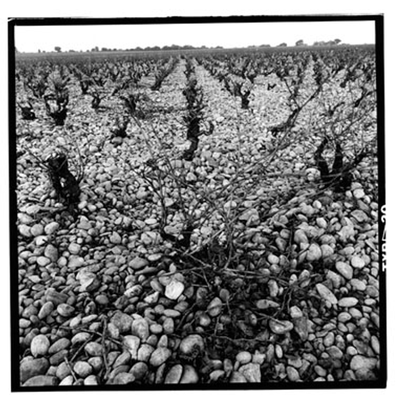Our blog was created to help make the world of wine and beer easier to understand and fun to navigate. There are a million things to know in this industry, we just want to help you understand the latest news and trends from around the globe. So sit back with your favorite sip and let's go on an adventure.
Peeking into Basque Country: Cider, Txakoli and a Meal
Peeking into Basque Country: Cider, Txakoli and a Meal
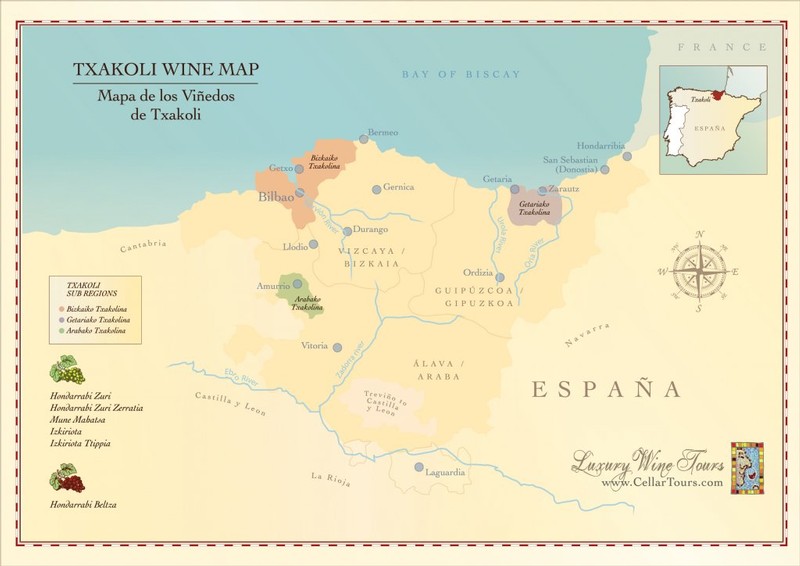
You walk into a building of stone and heavy, old timber, and are greeted by the smell of grilled beef fat, sheep’s milk, and apples. These are not perfect grocery store Honeycrisps. These apples are tart, bitter, and hard. These are apples with a past. You find an open spot at a table, probably standing, and as you settle in, you notice your neighbors. Everyone seems to be eating, drinking, and speaking all at once, and the low, hard ceilings bathe you in a language that has no western analogues. Your ears quickly decide that there are far too many x’s and z’s.
A server delivers a plate of chorizo and an empty glass. Someone shouts, “Txotx!” (which sounds to you like “Choach!”), and a queue of empty cider glasses with people attached to them forms in front of a giant barrel that you somehow missed when you came in. You join the line, and when you reach the front, a kind stranger taps the barrel, spraying a thin stream of cloudy, frothing cider into your glass. As you return to your table, you sniff. A little sour, a little funk, maybe a touch of cider vinegar. An omelet flecked with pungent salt cod has joined your chorizo. You fork yourself a bite of omelet and wash it down with a swallow of cider. The richness of the egg and the saltiness of the cod shake hands with the tannic brightness of the cider, becoming business partners in your mouth. Your server delivers a steaming heap of rare, bone-in beef to your neighbors, and tells you to finish your omelet, your steak is on its way. The call of “Txotx!” comes again, and you realize that your glass has mysteriously emptied itself. The meal has just begun.
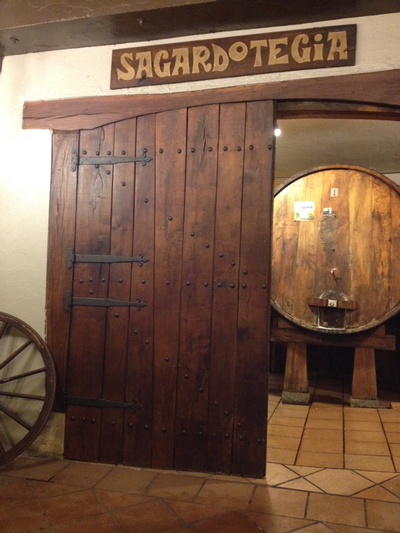
Photo courtesy of Chandler Briggs
Basque cider houses, or sagardotegi, have become an improbable tourist attraction in northeastern Spanish towns like Astigarraga and Hernani. Basque Country has a long history of cider production. Its fisherman and whalers were renowned in the 16th and 17th century, ranging far afield in ships fitted with internal cider casks. The crew members would drink up to three liters per day, staving off scurvy with the tart cider.
Basque cider, unlike other European ciders from England or Normandy, is generally still, though some show a light effervescence like Txakoli. They are dry, with little to no residual sugar, and can be quite tannic, like red wine or heavily steeped tea. They are the wild ales of the cider realm, unapologetically unfiltered and funky. The traditional Basque high pour (again, also used on Txakoli) acts like a splash decant for wine, blowing off some of the funk to reveal the fruit within. Basque ciders are delicious by themselves as an aperitif, but they really shine on the dinner table. Everyone has plenty of time to cook these days, so let’s make a Basque cider house dinner!
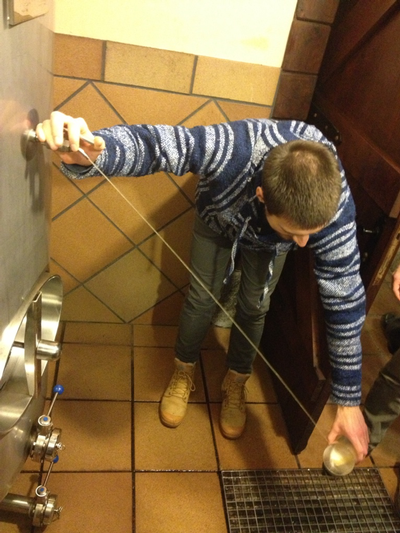
Photo Courtesy of Chandler Briggs
The traditional, protein-heavy sagardotegi menu begins with a plate of hard, spicy chorizo, followed by the salt cod omelet. Salt cod, or bacalao, is common throughout Portugal and Spain, and can be purchased online. It is a great pantry item, as the salt cure keeps it fresh for years. Remember to soak your salt cod for a day before preparing it, rinsing it several times in fresh water.
The second course is roasted white fish with grilled peppers. I prefer halibut, but you could also use (fresh, uncured) cod. Any small, green pepper will do, though I like shishito peppers for their sweet flavor and thin, quickly grilled skin.
The fourth and main course is the Txuleta steak, a bone-in rib steak grilled over coals. The steaks are sourced from cattle that are much older than the beef that Americans eat, usually 8-18 years old (most American cattle are slaughtered before 30 months). You can stick with a rib-eye for authenticity or branch out with an alternative cut. Erick Turner, owner of Butcher Butcher Walla Walla, recommends sirloin cap or hanger.
The final course is a cheese plate. Most Basque cheeses are made from sheep’s milk, reflecting their strong shepherding culture. The clean brightness of aged sheep cheeses like Abbaye de Belloc, Idiazabal, or Petit Basque helps to tame the wildness of the ciders. Manchego, Pecorino, or local Monteillet Fromagerie make fine, locally available substitutes. Traditional accompaniments include walnuts and quince paste, though sliced apple or pear will serve.
This menu is a little meat-heavy, so feel free to serve some veggie pinxtos (Basque tapas) to round out the meal. Asparagus is in season here in Walla Walla and in Basque country, so grill up some spears next to your peppers and steak. Spring onions will be coming on strong too. Serve them halved or quartered and grilled, ideally with a swipe of Catalan romesco (jarred peppers, tomato paste, nuts, stale bread, and vinegar makes this the ultimate quarantine friendly pantry sauce). Finally, no tapas menu would be complete without fried patatas bravas and lemony, garlicky aioli. Double fry the potatoes and use an immersion blender to take the broken-emulsion fuss out of the aioli. Txotx!
“We ate at long trestle-tables out of permanently greasy tin pannikins, and drank out of a dreadful thing called a porron. A porron is a sort of glass bottle with a pointed spout from which a thin jet of wine spurts out whenever you tip it up; you can thus drink from a distance, without touching it with your lips, and it can be passed from hand to hand. I went on strike and demanded a drinking-cup as soon as I saw a porron in use.” George Orwell, genius and apparent fuddy-duddy, in “Homage to Catalonia”
About the Porron
If a porron looks like a cross between a watering can and a decanter, that’s because it is! The porron is a hand-held glass pitcher that pours a thin stream of wine, ideally from a great height. You can drink anything out of a porron, but traditionally they are used for Txakoli, cider, or Cava. The porron is probably descended from conical Roman drinking cones named rhyton, and the Catalonians have perfected its use. To drink from a porron, place the spout close to your mouth and tip the pitcher. Catch the stream in your mouth, then slowly pull the container further away from your body, until it is at arm's length. The further the distance between the porron and your mouth, the more points you get. A porron is a crazy straw for grown-up drinks, and it makes your drinks taste better too. This stylish variation on the Basque high pour aerates your wine or cider, opening up the beverage just like a decanter. Grab your new porron and a bottle of Txakoli - or three - and pour on!

Photo courtesy of De Maison Selections
Let us not forget Txakoli!
Basque country straddles the Pyrenees on the border between France and Spain. Likewise, its most famous wine straddles the border between sparkling and still. Txakoli is a frisky, lightly effervescent wine, similar in style to an Italian frizzante. Originally, the wines were fermented in large wooden foudre, like the aforementioned ciders, though nowadays you are more likely to find stainless steel tanks. Stainless is a valuable tool because it allows the winemaker to control the temperature of the vessel. When fermentation has completed, the tanks are cooled to just above freezing, capturing and preserving the carbon dioxide that the yeasts have produced.
This kiss of CO2, when combined with low alcohol1 and whiplash acidity, make Txakoli one of the most energetically gulpable wines out there. These are the session beers of the wine world, wines that you can drink for hours without feeling weighed down or groggy. Before dinner, entertain yourself by learning the Basque high pour!
During dinner, Txakoli pairs well with darn near everything. These wines are literally zesty, exhibiting a touch of citrus pith that fans of Albariño or Pinot Grigio will be familiar with. This phenolic bitterness allows for pairings with classically difficult vegetable courses like baby peas or spicy salad greens. Follow the vegetables with clams in a parsley sauce, or crispy pork belly, or a fava bean and spring onion stew. Finally, finish your meal in true Basque-style with your cheese plate from earlier. You did remember to make your cheese plate, didn’t you?
[1] Single digit abv’s are not rare
Hospice du Rhône, Rhône Grapes in America & The Rocks District
La Terre Parle (The earth speaks)
Hospice du Rhône, the annual celebration of Rhône grape varieties and producers, was scheduled for April 22-24 before it was cancelled due to the ongoing Covid-19 crisis. Two of the cancelled seminars would have highlighted vineyards in the newly established (2015) Rocks District of Milton-Freewater AVA,1 a geologically distinct sub-AVA within the larger Walla Walla Valley AVA. Let’s celebrate local terroir from the comfort of our homes by learning about Rhône grapes in America and the people that have championed them!
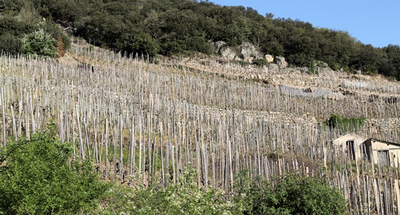
Cornas, Rhône
Hospice du Rhône
It started with a bottle of Viognier and a joke.2 Mat Garretson, one of the founders of Hospice du Rhône, was a red wine drinker until he popped a bottle of Domaine Georges Vernay Condrieu. He was cooking something that called for white wine, and he was about to deglaze the pan when the aroma of honeyed apricot stopped him in his tracks. This bottle of Viognier from the northern Rhône inspired him to create an appreciation society focused on the grape. He met John Alban, one of the Rhône Rangers (more on them later) and an early proponent of Viognier.3 Together, they would expand the society into a non-profit business league and international vintners’ association that meets yearly in Paso Robles. They promote producers around the country that grow and vinify Rhône varieties like Syrah, Grenache, Mourvédre, and Viognier. The Hospice du Rhône tastings and seminars are the place to rub elbows and exchange ideas with American and international Rhône royalty. Their director, Vicki Carroll, was recently named Wine Enthusiast’s Person of the Year.
Rhône Grapes in America4
Rhône varieties have been planted in the US since at least the mid-1800s. Old-vine mixed black plantings in California are usually Zinfandel-based, but they often include smaller amounts of Grenache, Mourvédre (Mataro), Carignan, Syrah, Cinsault, Counoise, and others. These grapes were typically picked together as a field blend, and it wasn’t until the 1970s that producers, inspired by the Rhône heavy imports of Kermit Lynch, began searching for single-varietal Rhône plantings.
Joseph Phelps released the first varietally labeled Syrah in 1977, and although everyone agrees that it was horrendous,5 Phelps remained committed to the variety. Gary Eberle, another Rhône fanatic, planted the first modern Syrah vineyard shortly thereafter, establishing Estrella River with vine material from Chapoutier in Hermitage by way of UC Davis.6 In the decade that followed, young winemakers like Randall Grahm, Steve Edmunds, Adam Tolmach, Bob Lindquist, and (the aforementioned) John Alban would all focus their production on Rhône grapes. By the time Grahm appeared as the “Rhône Ranger” on the April 1989 cover of Wine Spectator, the American Rhône movement was in full swing.7
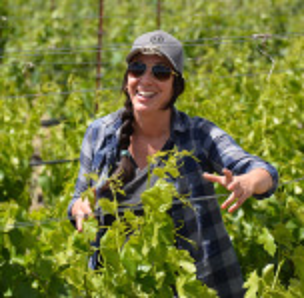
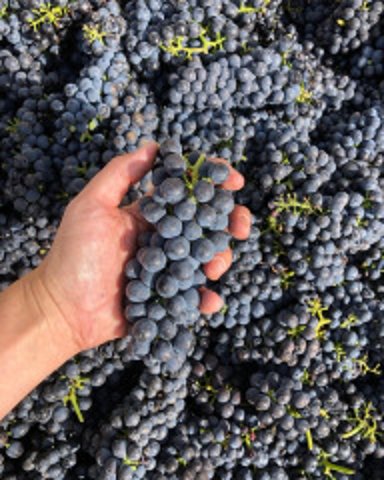
Brooke Roberston, Harvest at SJR Vineyards 2019
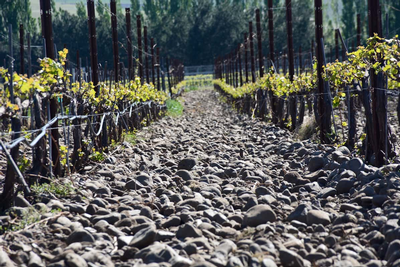
Rotie Rocks Estate Vineyard
Rhône Grapes in Washington
While California’s historic Rhône plantings predate the commercial Washington wine industry,8 there was varietally labeled Rhône wine made in the state as early as 1969 (Grenache rosé). While cold-tender Mediterannean varieties (especially Grenache and Mourvédre) can struggle with winter damage, Syrah’s home in the Northern Rhône is more continental,9 making it ideal for Washington vineyards. Mike Sauer, owner of Red Willow Vineyard in Yakima, planted the first Washington Syrah in 1986 using budwood that originated at Joseph Phelps.10 Eight years later, the Phelps (or Espiguette) Syrah made its way to Walla Walla, migrating south to Milton-Freewater shortly thereafter. There are many beautiful local expressions of Grenache, Mourvédre, Viognier, and other Rhône grapes, but this is the story of one grape and one place.
Rocks District Chateauneuf du Pape
The Rocks District of Milton-Freewater
The title of this piece comes from the cellar of Edmunds St. John. A member of the Peyraud family from Bandol, Mourvédre royalty, was tasting wine with Steve Edmunds. He came to a glass of Mourvédre, his eyes rolled back in his head, and all he could say was, “la terre parle.” Great terroir speaks, and the wines of the Rocks District speak loudly. The rocks that give it its name are alluvial cobblestones deposited by the Walla Walla river ages and ages ago. It was these cobblestones that drew a young Christophe Baron to plant Syrah in Milton-Freewater in 1997. He was reminded of the rocky terroir of famous Châteauneuf-du-Pape vineyards like La Crau. The AVA was established in 2015, covering a petite five square miles of rocky valley floor.
These free-draining, poor soils tame the inherent vigor and verve of Syrah, although the wines are anything but domesticated. The French have a term, sauvage (wild), that is frequently applied to the furry, sanguineous Syrahs of Cornas or St. Joseph. Wines from the Rocks District have sauvage in spades. They can smell like iron, or dry-aged beef, or creosote, like venison roasted on a campfire. Their texture, often buoyed by a high ph, is as soft and layered as a well-made bed, leading to a ferrous, saline[11] finish. Rocks District Syrah is a bear in a blanket, waiting for Goldilocks. The best examples can age for a decade or more, but they drink surprisingly well on release. Wine Spectator has called the Rocks District of Milton-Freewater “the most distinctive AVA in the United States.” I look forward to hearing what it has to say in the coming years.
[1] American Viticultural Area
[2] The Hospice du Beaune is arguably the most important annual wine auction in France.
[3] And other Rhone grapes. Alban’s selections of Syrah, Grenache, and others collected during his travels in France remain highly sought after.
[4] Anyone interested in a more detailed history of these grapes should find Patrick Comiskey’s American Rhone
[5] Waterlogged, virused vines struggled to ripen and the wine finished below 12% abv.
[6] The Estrella River selection remains one of the most planted Syrah clones in California.
[7] Not everyone in the Rhone Ranger camp was pleased with the French comparison. Sean Thackrey, who appears in Merriam Webster under “iconoclast”, famously complained that copying the French would stifle creativity and their Californian identity, to which Randall Grahm replied, “Sort of a coat-tails du Rhone?” See Randall’s blog for more wine geek witticism.
[8] Though many of the early home winemakers planted Cinsault (called Black Prince), one of the varieties allowed in Chateauneuf-du-Pape. There is still a planting of Cinsault in the Rocks District from 1930!!!
[9]When asked when he likes to pick, Gerard Chave answered, “Ideally before it snows.”
[10]I like to think of this wine synchronicity as an ouro-pour-os, or a wine glass drinking itself.
[11] Unbuffered potassium is a possible culprit.
Riesling Rocks!
“Sometimes I think that every mouthful of wine that is not Riesling is wasted.” - Joseph Jamek, to his importer.
My favorite piece of wine-based media is an old grainy video from the mid 90s.1 In it, Jancis Robinson MW sits at a restaurant, drinking a bottle of Riesling. She says that, for her, Riesling produces the greatest white wines in the world. The camera pans out, and you see that she is drinking a bottle of JJ Prum Wehlener Sonnenhur Auslese from 1949. It pans out again, and a helicopter shot reveals that Jancis is drinking her nearly 50 year old bottle of wine on the top of a castle overlooking the Mosel river. A dramatic guitar solo plays, I swoon, and the Mosel flows on.
My favorite quote about Riesling also comes from Jancis. She says, in a wonderfully snide attempt to explain this noble grape’s doldrums, that, “The problem with Riesling is that, unlike Chardonnay and Pinot Grigio, it has a very powerful flavor.” Great Riesling has heft and lift in equal measure, a lithe Fantasia hippopotamus dancing ballet on your tongue. Between Paul Grieco’s Summer of Riesling and Jancis Robinson’s tireless evangelism, you probably don’t need another wine geek haranguing you to drink more Riesling. Instead, let’s take a tour of some of Riesling’s haunts. It’s nice to get out of the house.
[1]Jancis Robinson's Wine Course (1995) Episode 6: Riesling https://www.youtube.com/watch?v=dtj9haNM9XY
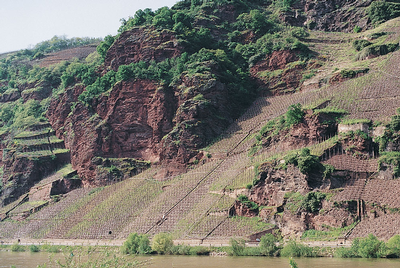
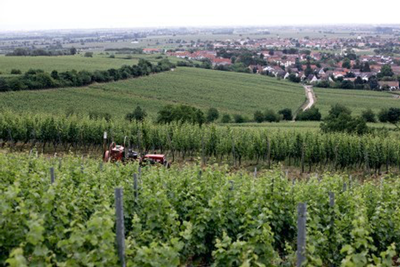
German Vineyards "Burgundian" Riesling at Von Winning
Germany
Germany is Riesling’s home, and it produces many of the variety’s best wines. German Rieslings have been classified using the pradikat system since the 1970’s, which organizes wines based on the ripeness of the grapes during harvest.2 Germany, especially the Mosel, is at the northern edge of Riesling’s ability to ripen fully, so it is no surprise that its finest vineyards are steep, southern facing slopes that bask in the sun. Before the advent of temperature control and selected yeasts, fermentations would continue until they stopped naturally, leaving a modicum of sweetness balanced by the region’s brilliant acidity. These halbtrocken (or feinherb) wines were the style that popularized German wines throughout the world in the 18th and 19th century, though they have been supplanted in recent history by the late-harvest wines of the pradikat system, and more recently by the powerful, dry Grosse Gewachs.3
Riesling is an incredible conveyor of terroir, so its flavors and aromas vary greatly depending on the vineyard or region it is grown in. Earlier harvested Kabinett or Feinherb wines are often floral, with swaths of honeysuckle and lemon curd. Riper regions like the Pfalz provide more tropical fruits like pineapple, and the botrytized late harvest wines often smell of candied ginger or saffron.
[2] Kabinett, Spatlese, Auslese, Beerenauslese, Trockenbeerenauslese, in ascending order of ripeness
[3] “Great growths”
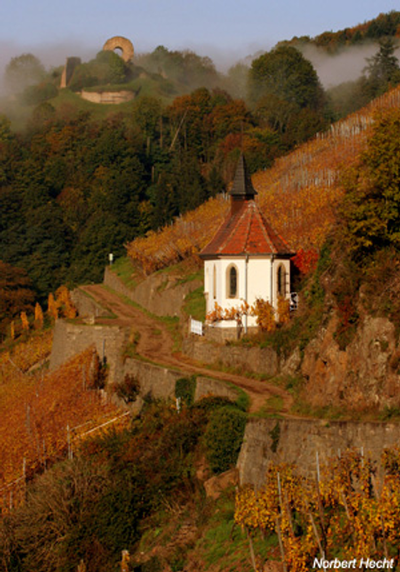
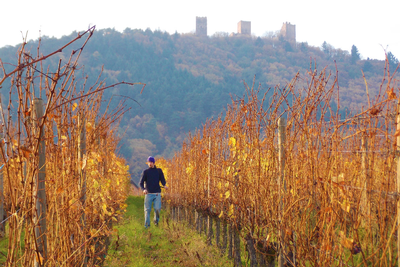
Alsatian Vineyards Samuel Tottoli in the Kuentz-Bas vineyards
Alsace
Just across the French border lies Alsace. While it currently resides within France, Alsace has changed hands several times in the last century or so, swapping back and forth between the Germans and French. As such, Alsace grows Germanic varieties like Riesling and Gewurztraminer, while also growing classically French varieties like Pinot Blanc. The incredibly diverse vineyards of Alsace4 have been organized into a series of crus much like Burgundy, though the Grand Cru wines must be made from either Riesling, Gewurztraminer, Pinot Gris, or Muscat.5
Alsace is warmer than most of Germany, and their Rieslings are sunny. They carry phenolic heft and dry extract that pairs well with the rich, often pork-based dishes of the region. Alsatian Riesling will have notes of ripe, golden citrus paired with a deep, mouthwatering minerality and a spicy finish.
[4] It has been said that Alsace has as much geologic diversity as the rest of France combined.
[5] With one exception: Sylvaner may be labeled Grand Cru if it comes from the Zotzenberg vineyard.

Clare Valley Vineyards
Clare Valley
Until recently, Australia was the second largest producer of Riesling in the world after Germany. The grape has been down under since the mid 1800s, and it quickly found a welcoming home in the Clare Valley of South Australia. The Clare Valley is north of the warm Barossa Valley of Shiraz fame, and it has a more temperate climate. Cold nights allow Riesling to maintain its signature acidity during long hang times, and marginal slate soils (much like the Mosel) elicit stone rampart structure in wines built for the long haul.
Clare Valley Rieslings are as breezy and refreshing as a fresh squeezed lime. They often exhibit aromas of granny smith apple and fresh cut flowers6 with a citrus zest finish. These wines also have a fantastic reputation for aging, packing some honeyed density onto their stony frame as the years flash by.
[6] And fresh tennis balls, if Ian Cauble MS of SOMM fame is to be believed.
And Beyond
These are just a few of the wine regions that produce fantastic Riesling. Washington has a long history with the grape, and there are more than 6,000 acres planted here today. Riesling’s cold hardiness (and general deliciousness) has made it the grape of choice for emerging and marginal regions, whether in Michigan, Vermont, or Poland. For myself, I know that as the days get longer and the sun hangs around, I’m going to be reaching for a bottle of Riesling. The saying goes that we talk dry but drink sweet. I think that now especially is the time to talk sweetly...and drink it dry.
Pink Bubbles
Pink Bubbles – Always a Party
Everyone loves pink bubbles. Full stop. It could be the illustrious Rosé Champagne Billecart-Salmon, or it might be sparkling rosé from an aluminum can - you know everyone’s having a good time when the pink bubbles come out. We could all use a little sparkle right now, so here are three of our favorite sparkling rosés from Italy and France.
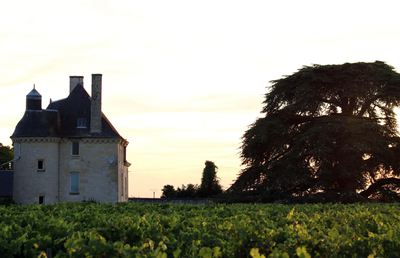
A view of Plouzeau’s estate
The Marc Plouzeau Perles Fines is one of our most popular wines in the shop. We always have one cold, at least when we can keep it in stock. This Cabernet Franc from the Loire simply does everything right. It’s crisp and clean without being angular, smelling like a cherry orchard and tasting of tangerine slices on a grassy picnic. The Plouzeau’s farm their 75 acres organically, including the replanted vineyards of Chateau Bonnelerie, and their attention to detail shows in this bottle.
Chateau Bonnelerie Marc Plouzeau Perles Fines Sparkling Brut Rosé
● Touraine, France
● Organic Vineyard with biodynamic principles
● “The bouquet shows lovely Cabernet Franc character in its mix of white cherries, a touch of tangerine, currant leaf, lovely soil tones and a bit of smokiness in the upper register.”
● Translates to “tiny pearls”
● Chateau Bonnelerie replanted its vineyards in 1976
● 100% Cabernet Franc
● 30 ha
● Traditional method sparkler
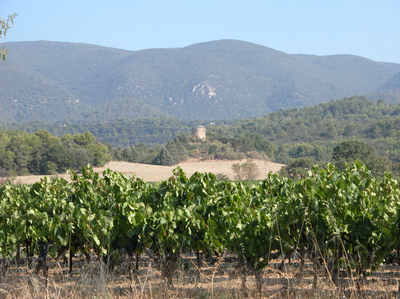
A view from Vielle Ferme
Further south, the Perrins of Chateau de Beaucastel also know a thing or two about growing tasty grapes. They source the grapes for La Vielle Ferme (“the old farm”) from limestone soils in Ventoux and Luberon. Both of these appellations on the border of the southern Rhone and Provence are known for their high quality/price ratio. Grenache, Cinsault, and Pinot Noir are direct pressed (rather than bled off via the saignee method) to stainless steel, producing an airy, citrusy sparkler that won’t weigh you down.
La Vielle Ferme Sparkling Rosé
● VdF, France
● Perrin family, 1970 started importing
● Grenache, Cinsault, some Pinot, direct press
● Limestone
● Stainless steel
● A nose of fresh red fruit (raspberry, wild strawberry) gives way to a palate of citrus(pomelo) and white flowers. [A field with a mountain in the background Description automatically generated]
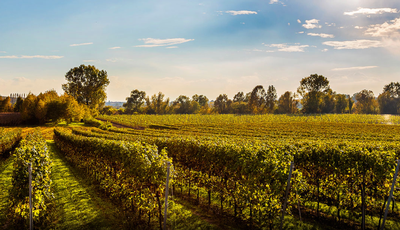
A view from Tenuta Maccan
Rounding out the parade of pink is the Le Monde Pinot Nero. First of all, Pinot Nero is a way cooler name than Pinot Noir (even if the Nero emperor sucked). This Friulian wine continues the theme by punching way above its weight. It is harvested early to preserve freshness, fermented dry, then refermented in tank using the Charmat method. It stays on the lees for 60 days, picking up a little extra breadth via autolysis, before it is bottled at spumante pressure with less sugar than most brut Champagne. It has round raspberry fruit and a soft, ticklish texture that demands sunshine and a yard.
Le Monde Pinot Nero Rosé Sparkling, Tenuta Maccan
● Friuli Grave, Italy
● 100% Pinot Nero
● Estate owned by Tenuta Maccan
● Charmat method, 60 days on lees
● Vine age 39 years
● 8 gram residual sugar/liter
● Gravel, clay, and calcareous soils
● Founded in 1970
Limestone
Talking dirty about limestone…
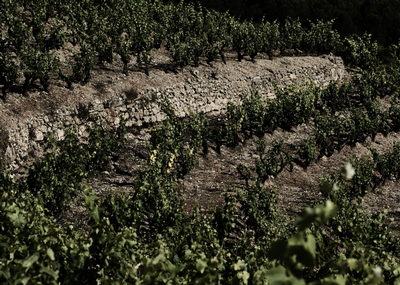
Vineyard planted on limestone, Celler de Capcanes
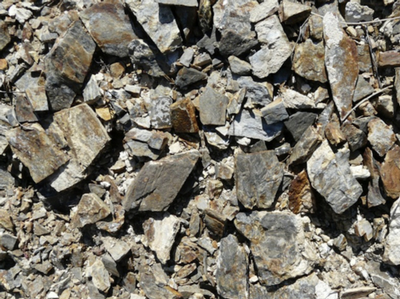
Limestone, Celler de Capcanes
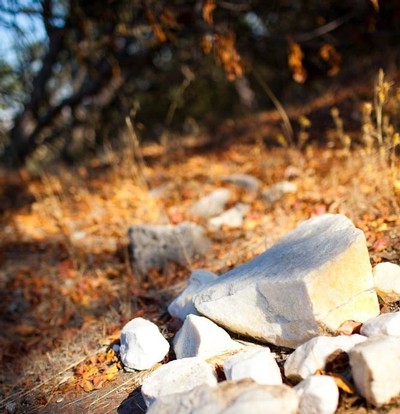
Limestone, Calera Winery
Winemakers can be a dirty lot. Sticky hands, purple feet, muddy vineyard trucks, the whole romantic shebang. A winemaker once told me a story of falling fully clothed into a one-ton fermenter, hosing himself off, driving home to change clothes, then coming back to the winery to finish punchdowns. Winemakers also love to talk dirt. To make wine is to be an amateur geologist, to know your water holding capacity, your soil temperature, your proportion of silt to sand or clay. The residents of the Mosel are very proud of their slate, 1 and the folks in Sonoma love Goldridge loam, but there’s one kind of dirt that fascinates the winemaking world above all others: limestone.
Limestone is made of dead dinosaurs. Ok, not really dinosaurs, 2 but that got your attention better than, “limestone is made of ancient dead pond scum,” even if that’s much closer to the truth. Limestone forms when tiny little creatures (corals, mollusks, etc) living in warm, shallow seas precipitate calcium out of seawater. Often, they use this calcium to build themselves a home (also known as a shell). When this calcium becomes a rock, it is called limestone. 3 The clay-rich limestone marls of Chablis and Sancerre, the Kimmeridgian soils, have visible prehistoric oyster shells in them. Limestone is also found in the Aube, in Piedmont, Alsace, Montsant, Saint-Emilion, and sections of California’s Central Coast. 4 There are many technical ways that limestone affects a vineyard, 5 several of which are still debated today, 1000 years after monks began classifying Burgundy’s many limestone-rich crus.
While the superiority of limestone terroir is far from a settled subject, it is indisputable that winemakers continue to seek it out. The draw of limestone has led successive generations of Californian winemakers to strike out for previously unexplored regions. In the late 1970’s, after several internships in Burgundy, 6 Josh Jensen spent years searching California for limestone soils. He found his slice of golden pond scum on Mt. Harlan, 7 where he would plant his estate vineyards and establish Calera winery. A decade later, the Perrin family of Chateau Beaucastel in Châteauneuf du Pape partnered with the Haas family to found Tablas Creek on a chalky series of hills in Paso Robles. 8 A decade after that, the Stolpmans would establish Stolpman Vineyard on a different piece of calcareous rangeland, this time in Ballard Canyon.
New World winemakers chase limestone because so many of the great vineyards in Europe are planted on limestone soils. What would the wines of the Cote d’Or be without limestone? 9 The cooperative Celler de Capcanes in Montsant has tried to quantify the differences between soil types by vinifying Grenache grown on four very different soils (slate, sand, clay, and limestone) in exactly the same way, then bottling each example separately in their Terroir Workshop line. They claim that their limestone bottling is fresher and more floral than their other wines. 10 Grab a bottle with our new Spanish bundle and see if you can taste the difference.
[1] Be it red or blue.
[2] Though the Jurassic period was named after the limestones of the Jura, where it was first identified.
[3] I am also a rank amateur geologist, so if this is offensively simplified, I apologize.
[4] There is even a deep calcareous layer in Walla Walla silt loam.
[5] Calcium availability, water retention, and grape ph, just to name three.
[6] Romanee-Conti and Dujac. Not a bad resume for pinot noir.
[7] Right next door to the appropriately named Lime Kiln Valley AVA, home of old vine Mourvedre from 1922.
[8] Calera and Tablas Creek have something else in common - they both have clones or vineyard selections named after them. Tablas Creek, unhappy with the available budwood at the time, imported selections of all 13 Chateauneuf varieties. The Calera “clone” of Pinot Noir was either smuggled into the country from the vineyards of DRC or selected by Jensen from heritage cuttings at Chalone.
[9] Or clay, for that matter.
[10] Which mirrors the results of a Decanter tasting of Languedoc wines grown on limestone vs schist.
Mencía
On zombie vines, wine wizards, and fresh ground pepper…
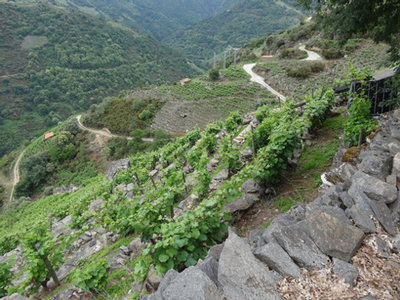
Mencía in Ribeira Sacra, from Jose Pastor Selections
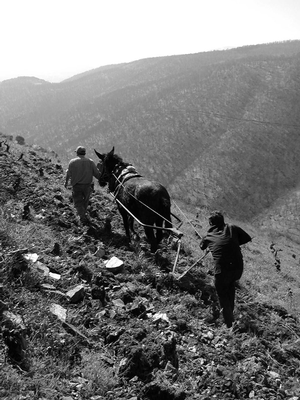
Descendientes de J. Palacios, from Rare Wine Co
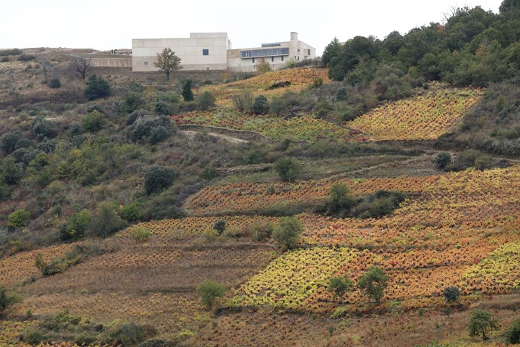
Descendientes de J. Palacios, from Rare Wine Co
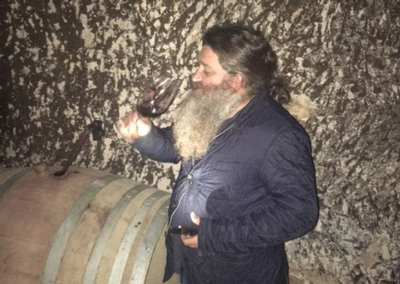
Raul Perez, from Skurnik
Mencía’s story will sound familiar to anyone who has navigated the wine industry’s constant, churning search for “The Next Big Thing!!!” 1 Old vines in a forgotten region: formerly overcropped, but returned to balance through the reticence of many decades, rediscovered and transformed by (often young) trained vintners searching for value outside of more established 2 regions. In the last 20 or so years, Mencía has been brought back to life by these wine wizards, some of whom3 famously sport preposterously mage-like facial hair. What is old is always new again, and what is considered unknown is still very familiar.
Mencía grows throughout northern Portugal4 and northwestern Spain. This region (the part of it that is in Spain at least) is sometimes known as Green Spain. It’s not the brutal (though still beautiful) Martian landscape of Priorat, nor the continental plains of Rioja. It is oceanic and verdant (In a word - wet). Red grapes grown in cool, wet climates at the margins of their ability to ripen, like Cabernet Franc from the Loire and Syrah from the far Northern Rhone, often exhibit more savory spice than those grown in more comfortable conditions. Fans of these reds will find their first glass of Bierzo or Ribeira Sacra5 hauntingly familiar, because Mencía has more spice than Paul Atreides.6 In fact, the aroma and taste of Mencía is often compared to a hypothetical cross between Cabernet Franc and Syrah, with a bit of Pinot Noir thrown in for good measure. It combines the fresh ground black pepper of cool climate Syrah with the autumnal cassia and herby bark spice of ripe Loire Franc. There are flowers too, and summer raspberries, but it’s that spice that lights me up every time.
Mencía first came to the greater wine world’s attention in the late 1990’s, when Priorat savant Alvaro Palacios and his nephew Ricardo established Descendientes de J. Palacio in western Bierzo. Alvaro had already helped to resurrect another Spanish region, Priorat, in the previous decade, and he saw many of the same building blocks in Bierzo. Their Petalos bottling, 95% Mencía, remains one of our favorite budget friendly reds from anywhere in the world, and their smaller production wines such as Corullon showcase Mencía’s impressive ability to age.7
If the Palacios family brought the world’s spotlight to the wines of Green Spain, then Raul Perez brought the mystery. Did he really age his Albariño at the bottom of the ocean? Did he really macerate his reds for months on end in his cave bear cellars?8 And, most importantly, what was he hiding in his Gandalf meets Dumbledore by way of Rasputin beard!?!9 If his Mencía is any indication, my guess is a pepper mill.
[1] See also - Etna, Tenerife, Mendocino County, Contra Costa, Chilean Pais, Muscadet, Mondeuse from the Savoie, Priorat, Beaujolais, the Rousillon, Sierra de Gredos Garnacha, etcx1000
[2] expensive
[3] Well, one in particular, but more on him later.
[4] Where it is known as Jaen
[5] There are also excellent versions being made in the new world, particularly in the Columbia Gorge by shop favorite Analemma.
[6] I’ll save my sandworm jokes for the next time we feature Chateau Rayas.
[7] I’ve had 10 year old examples that still needed hours in the decanter to fully open.
[8] With no sulphur additions to boot
[9] His nickname in Spain is “mago de los vinos”, or wine magician
Prospice
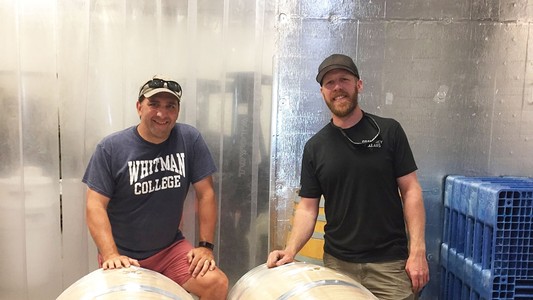
Who doesn’t love a buddy story? Woody and Buzz, Butch and Sundance, Syrah and Viognier! Prospice is, at its heart, a buddy story. Its co-owners/winemakers, Jay Krutulis and Matt Reilly, studied together at the Walla Walla Community College Enology and Viticulture program before founding their winery. They opened to the public in 2019, and we were immediately impressed by the elegance and definition of their wines. Matt and Jay craft beautifully balanced wines that are stylistically timeless while remaining firmly rooted in place. I can attest, having poured wine for both of them on multiple occasions, that they’re also super nice guys to boot.
Matt and Jay both worked as Cellarmasters for two of the best wineries in the valley (Gramercy Cellars and Tranche Estates, respectively) before striking out on their own. Their 2017 Les Collines Syrah puts this pedigree on full display. Partial whole cluster fermentation gives a wild, sappy edge to the classic blue plum of Les Collines Syrah. In fact, it was recently awarded 92 points and an Editor’s Choice from Sean Sullivan at the Wine Enthusiast. “Even in these difficult times, the dream is still alive for small producers in Walla Walla. There are very few regions where you can bootstrap a winery and produce 92+ point wines right off the bat,” says Sabrina Lueck, Instructor of Enology at the WWCC. We recently had a chance to taste their new Gamache Vineyard Viognier, and frankly, it was delicious. We expect big things in the future for Matt and Jay.
An Interview with Matt and Jay:
How did the two of you decide to make wine together? Tell us a brief history of the evolution of Prospice, in your own words.
We met in the WWCC Enology & Viticulture program, where we worked on a number of vineyard and winemaking projects together. One thing that was clear right away was that our palates were creepily similar — when tasting wines together, we will write the same tasting notes with alarming regularity. We also had similar visions for the wines we wanted to produce and the kind of winery we wanted to run, so it was a natural fit.
Compare and contrast your Les Collines Syrah with your Resurgent Syrah. They seem to be very different styles of wine, even though the vineyards themselves are fairly close.
Winemakers love Syrah for its expressiveness and diversity: It can exhibit fruit, spice, herb, and savory components in widely varying degrees of intensity, and it showcases terroir arguably better than any other variety. Our two Syrahs come from vineyards that are less than 8 miles apart, are the same Phelps clone vines, and are vinified very similarly, but they end up representing very different stylistic points on the Syrah spectrum. This difference is almost entirely attributable to the difference in the vineyard sites, and we love being able to pour these two wines together to illustrate the versatility of Syrah within our relatively small valley.
Les Collines is planted on rich, fertile loess soils hundreds of feet deep at the base of the Blue Mountains. Our Les Collines Syrah is all about texture, nuance, and complexity all in one. It combines dark fruit, beautiful herbaceous notes, and a mild salty, savory undertone -- each in an understated way, but which all combine to form a lively, expressive wine. It is, to us, a much more Old World-style expression of Syrah evocative of the northern Rhône valley.
Resurgent Vineyard sits on the valley bottom of the South Fork of the Walla Walla River and is planted in ancient riverbed soils, full of cobbles and basalt sloughed off the surrounding cliffs. The soil types are virtually identical to the famous Rocks District of Milton-Freewater, though Resurgent sits almost 700 feet higher in elevation, and thus sees much more influence from the mountains. Our Resurgent Syrah is much more brooding and savory, exhibiting a more smoky, meaty profile; however, we tend to find acidity and aromatic notes of citrus zest that tend to lift and brighten the overall profile just a bit, making the wine a bit more approachable than "Rocks" Syrahs can sometimes be. We attribute this brightness to the elevation and mountain influences on the vineyard.
With the current crisis, it is easy to forget that the valley recently experienced catastrophic flooding. I’ve heard that Resurgent Vineyard was dramatically affected. Will you still be able to source Syrah from this vineyard? Do you know anything about the vineyard’s future, and the general future of the South Fork/North Fork plantings?
Resurgent took a huge hit from the spring floods. A significant percentage of the vineyard was washed away entirely -- vines, trellising, the works. Other blocks had significant damage short of total destruction. We are somewhat fortunate that our Syrah block is the highest block in the vineyard, and farthest from the river channel itself, so it was largely unaffected by the flooding. We've obviously been in contact with Dr. Brack, who at last check in was in discussions with FEMA about the resources available to help rebuild and recover. He is optimistic about the ability for our vines at Resurgent to continue with relatively normal production in 2020, so we are hoping for the best, but there's no doubt that this is a significant blow to Resurgent's overall production and operations.
Your new Gamache Viognier is delicious. Do you have any favorite Viognier producers that you look to for inspiration, either in Condrieu or elsewhere?
Not particularly. We tend to think of the Prospice Viognier as everything we love about Viognier, made in our own style.
How do your vinification techniques differ depending on fermentation vessel (oak vs stainless)?
The only thing we currently ferment in oak is the Viognier (all neutral barrel fermented). Any differences in vinification are driven much more by the grape/wine that's being produced than by the fermentation vessel. For example, our vinification techniques for the Rosé and the Viognier are largely identical, even though the Rosé is fermented in stainless and the Viognier in oak -- but these obviously differ radically from the techniques used across the board in our red wine production.
What winemaking project of yours are you most excited about right now?
This is a little like asking which kid is your favorite! Honestly, we're still at a stage where we're primarily excited about Prospice as a whole, and getting it established and running sustainably. There may come a time when we have a pet project, or a specific block of fruit that we're really jazzed about, but right now what we find most delightful are the surprises or the unexpected developments. For example, Jay was really concerned about our 2018 Les Collines Syrah for more or less its entire life up until the day we bottled -- he worried that the acid was just too prominent, too tart. Now that it's been in bottle for a couple of months, we find ourselves enjoying it possibly more than any wine we've produced up to this point.
What do you hope to see Prospice accomplish in the next 5 years? (Winemaking or other)
More than anything, we would like to see the growth of an enthusiastic and devoted community around Prospice and the wines we're making. Critical acclaim and scores are great, and we've been fortunate to receive some great praise for our early releases. We'd love to reach a point at which Prospice is consistently mentioned as one of the most respected producers in the state (who wouldn't?). Honestly, though, that's less important to us than, say, a couple from Boise who comes into our tasting room for the first time and just falls in love with our wine, our story, and our experience. We just want to keep making wines that we're really proud of, and never sacrifice the commitment to craftsmanship and authenticity that's been central to everything we've done so far.
If you could make wine anywhere in the world other than Walla Walla, where would it be and why?
Jay: Pomerol or St. Émilion – while my first "aha" wine was actually out of the Graves on the left bank, I've consistently found the intricacies and complexities of right bank wines, rich with yummy Merlot and Cabernet Franc, to be the most inspiring for me.
Matt: Rhône Valley in France - I have always been Rhône focused. My appreciation for all wines, regions, and styles has grown immensely during my time in the wine industry, and even more so once we began production of our own wines, but I have always gravitated towards Rhône or Rhône influenced wines.
What other wineries or wine professionals have you drawn inspiration from? What businesses and people outside of the wine industry have inspired you?
Jay: I don't have any "wine heroes" or any wineries that I've always idolized, to be honest. I will say that dozens and dozens of colleagues in the industry here in the Walla Walla Valley have been unbelievably generous and supportive -- I won't start listing names, because I'd inevitably leave one or two off. But I am so grateful to be living out this wine dream in Walla Walla, because I think the community here is so uniquely supportive of all its members. Outside the wine industry, I'd say Steve Jobs -- a guy who was unrelenting in the pursuit of his vision and his passions. I think personally I wouldn't have gotten along with him at all, but I deeply respect what he achieved. He also gave a commencement address at Stanford in 2005 (check it out on YouTube) that was influential on my own thinking as I made the decisions to step away from my corporate legal career and pursue this wine dream.
What would you like consumers to know about your business during this crisis?
That we will survive, and thrive on the other side. We appreciate everyone who finds a way to support us right now -- if you have the means and desire, by all means, we'd love for you to buy some wine. Our Wine Club members are amazing -- having a big community of customers ready and eager to receive our wines, and in many instances adding wine to their spring shipment, is a massive help in being able to keep the lights on and keep rolling.
But we know this is a time of huge uncertainty, worry, or fear for many people. Nobody should feel uncomfortable or bad if they don't feel able to spend money right now for what is, let's face it, a luxury good. We are in the enviable position that our main asset is arguably just getting better as it sits in barrel and bottle a little bit longer before we sell it!
Are you offering delivery? Pickup? Have you changed your shipping policies?
Absolutely! We are happy to provide free delivery to anywhere within reasonable driving distance of Walla Walla. We are also offering $15 flat rate ground shipping for all orders, with shipping included for any order over $400.
How have you been occupying your time during “shelter in place”? In what ways has your life been affected outside of your work?
Jay: I am very much an introvert at my core, so the current circumstances play right into my comfort zone in a lot of ways. I think a key to maintaining an even keel in this kind of situation is to focus on the things you can control, and try not to worry about the rest. Certainly I have been spending a lot of time thinking about things I can be doing to stabilize, develop, and grow our business -- things like the live online tasting we did last week, or thinking about possible landscaping work at the tasting room. I have also been trying to appreciate the fact that this kind of "break" doesn't come along very often (I hope!), so I am also trying to make the most of that fact, and enjoying more leisure time. Reading more books, playing games, going for walks with my wife, things like that. I realized last spring that I typically won't be much help with gardening with the tasting room is open, as our spring weekends are generally peak season -- so I am trying to take advantage of this opportunity to be out in the yard and garden much more this year.
Matt: I have been getting a lot of quality family time, and in some circumstances too much quality time...any parent gets that. With schools and childcare programs closed down we have a 5 and 2 year-old to keep track of each day. My wife works remotely for a company on the east coast, so I watch the kids in the morning while she works and then I take care of my work responsibilities in the afternoon or at night. We look forward to an eventual return to "normal days" but consider ourselves lucky that we have the flexibility to approach each day in the manner that we do.
Have you had to delay any rollouts or changes to your business because of COVID-19?
It remains to be seen how sales progress through the year, but we will almost certainly delay some future releases because of this slowdown. We are not entirely unhappy about it -- since opening we've had a desire to have the opportunity to give some of our wine more time in bottle before release.
No one really seems sure how long the pandemic will last, with estimates ranging from weeks to months. How long can your business survive the current climate?
We have been extremely disciplined and deliberate with everything we've done since starting Prospice. As a result, we've ended with production slightly larger than where we thought we would be at this point, without cutting any corners on any of the critical inputs (e.g., no compromises on fruit sourcing, barrel program, etc.) — but by focusing very hard on controlling costs and lots of sweat equity from us, our families, and our friends, we've kept costs as tightly controlled as possible. So aside from a truck loan, the business is debt free, with lots of assets in barrel and bottle. We are admittedly fortunate that neither of us is reliant on the winery for household income at this point -- that would be a game changer, no question.
Short answer, we are as confident as we can be, given all the unknowns, that Prospice is in a good position to ride this out until we can get back to what we'd all rather be doing.
itä Wines
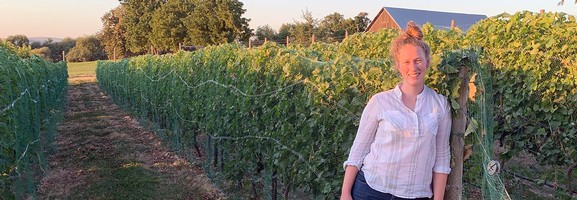
We love the east side of Walla Walla. The weather is different, the trees are different, the animals are different (bears and elk and mooses, oh my), and the wines are different too. They marry the sunny power of eastern Washington to a streamlined, frisky structure. Kelsey Itämeri, the owner and winemaker of newly founded itä Wines, draws all of her grapes from cool, high elevation sites on Walla Wall’s east side, leaning into the brisk freshness of vineyards like Les Collines (which appropriately translates to foothills), Breezy Slope, and her family’s farm.
We recently had the opportunity to taste two different bottlings of 2019 Les Collines Semillon from the young winemaker.
“The packaging is smart, sharp, and so is Kelsey. She’s never been one to do things the usual way,” says Sabrina Lueck, Instructor of Enology at the WWCC.
The first was fermented and aged in stainless steel, and it is delicious. You could almost taste the wind in it, with its crisp fruit and taut structure. The second was fermented and aged in neutral oak, a Semillon with a bit more meat on its bones. Maybe it was the current atmosphere of uncertainty, but we really loved the warmth and generosity of this one. Don’t get me wrong, it is not a big or heavy wine. The east side lift is there, like a fresh squeeze of lemon on a home-cooked plate of food. This is comfort wine, pure and simple. Have a second helping.
An interview with Kelsey Itameri:
What other wineries or wine professionals have you drawn inspiration from? What businesses and people outside of the wine industry have inspired you?
Oh man, so many! I love making white wines, something that I first realized while I was working at Balboa Winery with Tom Glase and Tyler Grennan. Then I had the opportunity to work with Ali Mayfield when she was at The Walls Vineyards (she’s now at Wahluke Wine Co.). She’s an amazing winemaker, especially when it comes to white wines and it was great to work with her and pick her brain every day. Virginie Bourgue of Lullaby Wines has also been an incredible mentor - she helped my family prepare and plant a test plot of grapes at our property in the foothills of the Blue Mountains and she’s been an incredibly wise and calming teacher as I went through the throes of trying to manage the test vineyard without knowing anything about plants and then making wine in my garage and kind of messing things up, but also kind of doing things right… It was all over the place, viticulturally and enologically for a bit and she really helped me keep an even keel.
Outside of the wine industry I draw a lot of inspiration from small business owners within my family. My late grandmother, the inmutable Lataine Garrick, was a firecracker! She had four kids and still started several of her own businesses, first making and selling praline candies to the Bon Marché in downtown Seattle, and then founding and operating a successful clothing company for tall women for many years (all of the women - and men- in my family are quite tall). When things are tough I like to remind myself that they were almost certainly tougher for her, and she still got through it. I’m also very inspired by my parents, both of whom have founded and run small businesses throughout my life. They’ve really shown me that you can pave your own way in life.
Why did you choose to focus on east side vineyards? Could you describe the soil and climatic conditions of east side vineyards, comparing and contrasting with other parts of the valley? How do you feel these differences show themselves in the resulting wines?
I chose to focus on vineyards on the eastern side of the Walla Walla Valley because that is where my family’s farm is and eventually, I’d like to grow all of our grapes on that land. I figured that in the meantime, I might as well try to learn as much as possible about what grapes are doing well along that ridgeline and really dig deep into that terroir as much as possible.
Right now I source from Les Collines Vineyard and Breezy Slope Vineyard, both of which have silt loam soil types, as does my family’s property. The elevation of both of these vineyards is higher than most of the rest of the valley, with Les Collines ranging from 1100-ish to 1370 ft above sea level and Breezy Slope is at 1700 ft above sea level. This elevation has a bit of a moderating effect - in the summer it is not as hot at these sites as in the “bowl” of the valley and in the winter it is not as cold.
In terms of how these aspects of the vineyards show themselves in the wines: As a consumer, I like higher acid, lower-alcohol wines, possibly because my hangovers have gotten so much worse since I turned 30… In any case, I think that these sites are very good for producing that style of wine. In addition, the moderation of the climate compared to some other parts of the valley makes it so that some of the more delicate flavors from the grape aren’t as susceptible to being burned off during our crazy heat waves, which really adds depth and complexity to the wine. The resulting wines all share a lighter-bodied, savory, highly complex and striking character no matter what the varietal, so I avoid over-ripening or manipulating the wine to preserve that.
Could you describe Les Collines vineyard, the blocks that you source from, and what you think are some of that vineyard’s signatures?
I think that Les Collines Vineyard is one of the bangin-est vineyards around, but I am incredibly biased because I buy most of my fruit from them. That said, the management is top-notch - Brad Sorenson and Brooke Robertson really know their stuff and they’re always incredibly patient with me when I ask them a million vineyard questions, both for itä and when I’m thinking about my family’s test plot. Les Collines is known for their Syrah, especially from some of the higher elevation blocks. I got really lucky to be able to scoop up a ton of Syrah from block 46 in 2019, which is pretty high up on the hill. The Syrahs from there are just incredible - savory and intriguing while still retaining a bit of delicacy, especially on the nose. I think I heard someone refer to it as “mountain wine” which to me conjures lovely images of Heidi hiking through the Alps eating tiny mountain strawberries by a brook. I also source Primitivo for our rosé from block 27 lower down on the property, which is very close to the Petit Verdot block 10 fruit I use. The Merlot is sourced from middle of the hill in block 33, and probably one of the most under-rated fruit sources in Walla Walla - Les Collines Merlot has beautiful aromatics. One site-specific note is that both of our Sémillon wines are from Les Collines, one sourced from the top of the hill in block 51, and the other from the bottom of the vineyard in 4a. I thought the lower-lying fruit would develop a little less quickly due to less sun exposure and ripening potential, but in fact it turned out ripen a earlier and the lower-lying 4A went into the barrel-fermented sémillon 2 of 2, while the hillside grapes from block 51 went into the leaner, crisper sémillon 1 of 2.
Semillon makes some of the great wines of the world, from Sauternes in Bordeaux to the Hunter Valley of Australia. What drew you to Semillon? Why two of them? What are some of your favorite Semillons from Washington and abroad?
Real deal answer: it was available. Honestly, there’s not that much white wine grown here in Walla Walla, and I had limited myself even further by sourcing only from the eastern foothills. I chose Sémillon because it is a neutral grape, as opposed to the very aromatic wines produced from Riesling or Sauvignon Blanc. I wanted a neutral grape because I wanted to do a side by side production in stainless and neutral oak barrels to show the impact of winemaking on the finished wine.
Well, it’s kind of hard to find Sémillon bottled on its own, but I’ve had some lovely Sémillon-Sauvignon Blanc wines from Washington as well as from Bordeaux. Also, if I could afford it, I would have Sauternes for dessert every day… That said, hands down, my favorite wines are chardonnays from the Côte d’Or in Burgundy or Champagne. It’s always the right time for Champagne.
How do your vinification techniques differ depending on fermentation vessel (oak vs stainless)?
For the sémillons, both were picked on the same day and they had very similar chemistry even though they are from different blocks at Les Collines. The block with slightly higher Brix went into the barrel-fermenting program since the higher alcohol would give that wine a bit more weight. In general, I like to ferment white and rosé wines at a lower temperature, so they all went through a long, cool fermentation to preserve delicate aromatics. Toward the end of primary fermentation, the barrel fermented wines had some battonage (lees stirring) once to twice weekly to add some more body to the finished wine. The barrel fermented sémillon also had a complete malolactic fermentation, whereas the stainless fermented sémillon and rosé did not. Since the stainless sémillon and rosé had residual malic acid, they were both sterile filtered prior to bottling, whereas the barrel-fermented sémillon is unfiltered.
You recently worked a harvest in Burgundy. Where did you work, and what was the day to day work like? Did you learn any cellar tricks? What were the biggest differences between Burgundian cellar techniques and those that you’ve experienced in Washington? What were the biggest differences between the vineyards? What were some similarities?
I did! I worked at Domaine Jean Charton in Puligny-Montrachet, where they make top notch grand cru and premier cru chardonnays, in addition to some village level whites and two tiny lots of pinot noir. It was an incredible experience and I kind of had to keep pinching myself during the first week or two of work. We started every day at 7:30 in the morning, and if I was in the cellar that meant getting the press and grape elevator ready before the first fruit came in, helping to take brix and temp on fermentations, and maybe going out to sample vineyards that hadn’t been picked yet. At 9:30 AM we took a break for casse-croûte, which is a snack of baguette, cheese or sausage, and wine. It only happens during harvest and it is pure magic. When grapes came in from the vineyard, everyone loads up the press and then I would clean the elevator. When the press cycle was over, I would clean the press pan and get ready for the next press load. When there was juice to get barrelled-down, I would clean barrels and mark them with the lot numbers. Lunch would happen from about 12-1:30 and during harvest everyone eats together and there’s amazing 3 course lunch every day. Then its more loading of the press and cleaning of the press, etc. Afternoons were also when innoculations would happen to start fermentations. There were 2 presses and sometimes we would have 10-12 total pressloads a day… They really had it down! And sometimes I would be in the vineyards picking or scouting for pests or counting missing vines to prep for the next year.
Cellar tricks! I don’t know. They have the coolest tools and I’m sure that trying to describe them with words would make me sound insane. Where I worked they didn’t use barrel racks, just wooden chocks, so I had to learn how to “drive” a barrel by rolling it on its head. It was not pretty at first. Also, I will not work another harvest without casse-croûte - definitely a tradition I’m bringing to itä wines.
Differences in the cellar - Americans are constantly sanitizing everything, and that was not the case where I worked. But we’re playing different games. In Walla Walla there’s fruit coming in for 2-3 months versus 2-3 weeks in Burgundy. Things would get disgusting over that amount of time if they weren’t being thoroughly cleaned. Additionally, working entirely with white wines with a pH of 3.1-3.3 vs. working with Syrah from the Rocks with a pH of 4 opens you up to a whole different level of microbiological risk. So, different strokes for different folks.
Biggest differences in vineyards was vine spacing, training and height. The vines are planted meter by meter, so if you’re standing between two rows, they’re almost touching you on either side, and they’re not trained very high, so I could just straddle a row and hop the wires if I needed to move to a different row. Also no drip irrigation.
Similarities: This is going to sound like I’m tooting my own horn, but the way that the slope of the Côte d’Or dropped down to a very fertile plain full of wheat production did remind me of the foothills of the Blue Mountains. Also, I had just taken Weed Identification at WWCC and we have so many of the same weeds! I have a whole album of weed pictures I took in Burgundy on my phone. Because I’m a very cool person.
Tell us about your family's vineyard. Where is it? What’s planted? What are the wines like? What are some of the challenges that you have faced? What are your plans for the future of this vineyard?
My family’s vineyard is actually an acre test plot. It is located southeast of the town of Walla Walla in the foothills of the Blue Mountains pretty much smack dab between Les Collines and Breezy Slope. In the test plot we have 10 different varietals of grapes planted: Aligoté, Chardonnay, Pinot Blanc, Sauvignon Blanc, Sémillon, Pinot Meunier, Pinot Noir, Syrah, Malbec and Cabernet Sauvignon. Additionally, we have 3 varieties of cherries, 2 varieties of apples, nectarines, peaches and raspberries planted.
The wines are crazy! They all have very nice acid and an interesting savory note to them. They’ve all been dry farmed for the past two years, and they have very high YAN, which means that I haven’t needed to add nutrients to the must to finish fermentation.
Challenges have been that I moved here from a big city and knew nothing about plants or fermentation! The first few years were rough, especially when it came to managing powdery mildew. But I went to school and we got a real sprayer for the vineyard and that’s really helped make it so that I don’t cry every time I go there. It’s also been a challenge making the test plot wines in my garage. There’s no drain, the water has chlorine in it so we have these ghetto ass filters you screw on to the hose from Amazon. And we have 10 freaking micro lots of wine… so it’s finicky.
We’d love to plant a commercial scale block or two and start sourcing from there for itä wines!
What is your desert island wine?
Champagne! Grand Cru Burgundy!
How has your business been affected by the virus?
Well, I had this grand plan to get a boatload of interest in itä wines by pouring at Taste Washington, which was scheduled for March 21-22, and then move straight into opening our tasting room the following weekend (March 28-29) when I would work out all of the opening weekend kinks in time for WW Spring Kick Off Weekend the first weekend of April. As you know, Taste Washington and the WW Spring Kick Off Weekend were both cancelled, and in a supreme moment of irony, the order to close tasting rooms was enacted on the same day as my final County Health inspection for the tasting room. I’ve had to pivot to online sales (something I know/knew very little about) and hope that all of the friends and family who have ordered wine actually like it! It’s tough not being able to give folks the chance to try before they buy, especially since itä wines is a completely new winery.
In the latest Silicon Valley Bank State of the Wine Industry report, they addressed the contemporary tasting room and club model with this question, which seems particularly salient now during the pandemic: “In an increasingly digital world, what industry would insist that its consumers first physically come to its place of business to buy its wares?” How has your business addressed this tension? Have you changed your practices or sales focus in the face of COVID-19?
Yes, we’ve pivoted to entirely online sales and trying to make sure that our web presence is representative of the brand and that it “feels” as similar as possible to the vibe we were going for in the tasting room. That said, I think people are going to be jonesing for a wine country weekend when this is all over, and the tasting room experience is an integral part of that type of escape.
I know that, before the ban, you were planning to open your tasting room in the incubators. Is the space finished? Has there been any discussion of rent forgiveness or postponement in the face of the crisis?
The space is 99% finished… I’ve left some projects on hold since I know I won’t be able to open for a bit and the focus is now squarely on online sales and marketing. I think there has been some discussion about rent forgiveness, but I’m not sure what the status is there.
What would you like consumers to know about your business during this crisis?
We have wine to sell! And we can ship to most states in the US! We are offering free delivery in the Walla Walla area and $15 ground shipping on orders of 6 or more bottles to help folks stock up while staying home. Right now we are offering our whites and rosé from 2019, our inaugural vintage. In the fall we will release our 2019 Pinot Noir from Breezy Slope and in 2020 our remaining reds - a Syrah and Merlot/Petit Verdot blend from Les Collines Vineyard.
Are you offering delivery? Pickup? Have you changed your shipping policies?
Yes, free delivery of any order in the Walla Walla area and $15 ground shipping on orders of 6 or more bottles.
No one really seems sure how long the pandemic will last, with estimates ranging from weeks to months. Can your business survive a prolonged shutdown?
Ummmmm I sure hope so. I think that there are advantages and disadvantages to being a business that is just starting up. In terms of disadvantages, I don’t have a large customer base or wine club that I’ve built up over the years, and no one has ever heard of me as a winemaker or itä wines as a brand. So that’s an uphill battle - every single customer so far has bought wine blind… On the other hand, we’ve been really scrappy in terms of making sure our “burn rate” is as low as possible. I’m the only employee at the business, so I don’t have to worry about grappling with laying off other workers. Most of my wines that I’m selling this year are in bottle already, and I won’t have another big round of expenses until the fall during harvest, so maybe we can squeak by. Changing our level of production is always a possibility.
Ducleaux Cellars
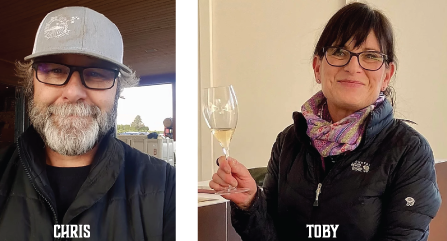
What do you keep in your garage? Probably a car, or a lawnmower, maybe some tools. How about a small winery? Toby Turlay and Chris Dukelow produce their small lot wines in their garage turned winery, continuing a garagiste tradition that has its roots in Bordeaux. They craft white, rosé, and red wines in their Rocks district garage, but it was their pet-nat that really caught our attention. What’s more fun than impeccably made wine from a garage? Impeccably made sparkling wine from a garage!
Pet-nat, or petillant naturel, a sparkling winemaking style that has taken the world by storm recently, has deep old-world roots (much like making wine in a garage). It goes something like this:
Rather than going through the complicated, multi-year rigamarole of traditional methode champenoise, a winemaker making pet-nat simply waits until their fermenting grape juice is at the correct sugar level, then sticks it in a bottle, often under a bottle cap rather than cork. The yeasts in the wine will continue to eat sugar and produce CO2, which will be trapped in the bottle, causing carbonation. Hurray, bubbles! We are very excited that more local winemakers are experimenting with this technique, producing joyous wines that seem to disappear faster than physics should allow. We could all use more bubbles in our lives, especially if they’re artisan garage bubbles from a small, exciting new producer like Ducleaux Cellars.
An interview with Toby Turlay and Chris Dukelow:
Ducleaux Cellars is named after one of you. Can you tell us that story?
The name originated from Chris’s last name, Dukelow. The Dukelows originated in France and the spelling was probably Ducleaux or Duclos. They were Huguenots (Protestants), were persecuted by Catholics, and they fled to Ireland in the 1600’s. The potato blight brought them to the US in the mid 1800’s. The Huguenot Cross has concentric Fleur de Lis and is part of our label.
How did the two of you decide to make wine? Why Walla Walla?
There are two different story versions. (1) Chris grew up in Richland and moved to Seattle for his professional career. Returning to visit his parents periodically, they would go wine tasting and Chris became enamored with the winemaking craft and “perceived” lifestyle. Between jobs in 2011 we decided to make wine in our garage as a hobby. This hobby spiraled into bonding our garage and doing our first commercial vintage in 2013. Since then, Chris attended the Northwest Wine Academy and Toby the Walla Walla Enology and Viticulture program. We wanted to move to Eastern Washington wine country to escape the craziness of Seattle and loved the soul and vibe of Walla Walla. We found this amazing house and property in the eastern most corner of the Rocks District with an unobstructed view of the Blue Mountains. It was love at first sight.
(2) We have a combined family with 6 kids and there was a 9 month period where all of them were teenagers at the same time. Given the kid’s milk consumption and our wine consumption, we were faced with the dilemma of either buying a cow or starting a winery. A winery seemed like a better long term solution.
Has Ducleaux Cellars opened to the public yet?
No, our plan was to open at the beginning of April, but obviously that has been put on hold. We will open as soon as it’s safe and the all clear signal sent.
When did you start? How many cases do you produce? Do you have a specialty or focus, either varietally or stylistically?
We started commercially with the 2013 vintage and stayed very small (<400 cases annually) until the 2018 vintage when we became more serious about growing the winery. We produced a little over 1000 cases in 2018 and 2019. We expect to make approximately 1,500 to 2,000 cases annually from our new estate Rocks District vineyard. Stylistically, we are predisposed to Rhone inspired blends with little to no new oak. Toby loves sparkling and will always do something with bubbles annually.
Does Ducleaux Cellars have any vineyards of their own? If so, what approach are you taking in the vineyard?
We currently have 8 acres of new vineyards planted in the Rocks District which will start to produce in 2021. We planted Syrah, Grenache, Mourvedre, Cinsault, Viognier, Marsanne, Roussanne and Grenache Blanc. The vineyard is managed by Chris Banek, one of the top viticulturists in the Northwest. We are trying to farm sustainably and Salmon Safe.
We love the Ducleaux Call Sign Pet Nat, and we’ve been really excited by the growing number of Washington producers that are producing them. Take me through the production of your pet nat. How do you make your picking decisions? At what point during fermentation do you bottle it? Is it disgorged?
We love the Pet Nat craze! Toby wanted to make a true Methode Ancestrale wine and keep it very natural. Although it looks like a white grape, it’s 100% Grenache that was picked early to keep sugars low and acid high. At harvest, brix was 19.5 and PH of 3.23 and she felt the phenolics had developed sufficiently to pick. There is a rule of thumb that for every 4 grams/liter of remaining glucose/fructose you get 1 bar of pressure (Champagne usually has about 6 bars) from further fermentation. We wanted Call Sign to be around 4-5 bar so we bottled at 16 grams/liter and kept it in a warm room to finish fermentation. We don’t disgorge, so you’ll get the murky lees at the bottom. Chill upright to let the lees settle. When pouring, it will get more cloudy. This is natural. The name “Call Sign” was chosen to honor Toby’s father, a career Naval Aviator, whose call sign was “Champagne One”.
What is your vision for Ducleaux Cellars in the next 5 years?
We want to be the fun, non-pretentious winery that you always want to visit when you are in Walla Walla. Serious wines by not so serious people. We have great Rocks District wines at a fair price and it’s the place to bring your friends and family to share a glass, hang by the firepit, play shuffleboard and have a picnic with a great view.
If you could pour your wines for anyone in history, who would it be and why?
Toby: I don’t have a specific person in mind, but it would definitely be someone in France before the phylloxera outbreak. If I could go back in time, I’d travel around France, work the land, go through harvest and see their winemaking process. I’m sure I’d have to work on not freaking out about their sanitation practices. It would be interesting to see their reaction to our style of wines today. If I had to choose one person, it might be Marie Antoinette. I’d love to hear what she was thinking and why she made the choices she did.
Chris: It would be amazing to sit down and pour wine with Thomas Jefferson and John Adams and talk about the current state of affairs. While imperfect in many ways, both of them practiced civility and unselfishness in helping to craft this amazing democratic experiment while having wildly different views. In spite of their differences, they became very close friends corresponding until their deaths on the same day, July 4, 1826 (50 year anniversary of signing the Declaration of Independence). What a novel idea that you can be friends, be civil, while disagreeing on many things.
If you could make wine anywhere in the world other than Walla Walla, where would it be and why?
Southern Rhone areas of Chateauneauf du Pape and Gigondas and the Champagne region. The beautiful old small villages and vineyards, amazing food and wine along with a simpler life. We’ve been once and we loved it. We’ve found some of Toby’s ancestors are from the Loire Valley, Bordeaux and Champagne regions.
What other wineries or wine professionals have you drawn inspiration from? What businesses and people outside of the wine industry have inspired you?
We both have a background in sales and marketing and an entrepreneurial spirit. Chris’ expertise is business development, launching new tech companies and the financial side while Toby has more expertise in identifying new trends and customer experiences. We were drawn to family wineries with interesting stories, such as Dusted Valley, Cairdeas, Guardian Cellars and Kiona.
What would you like consumers to know about your business during this crisis?
We’re a small business that was just about to launch when this hit. It’s unfortunate, but we’ll be ready when the virus subsides. We’ve got a ton of projects to complete in order to open, so in some ways, the crisis is helping us focus. We are happy to offer curbside pick-up and local delivery.
Are you offering delivery? Pickup? Have you changed your shipping policies?
We are offering both delivery and pickup along with a 20% discount. We also are offering free shipping for our customers beyond the local area.
How have you been occupying your time during “shelter in place”?
Working on finishing our guest houses, long walks on country roads, blending trials for our 2018 reds and 2019 whites, binging on The Newsroom, The Expanse and the trainwreck called Tiger King :-). We have a running scoreboard for our Sequence game.
In what ways has your life been affected outside of your work?
The realization of how Tom Hanks made a real friend with a volleyball called Wilson in Castaway. We really miss our kids, our family and our friends. Everyone is coping in their own way. Some days are more of a struggle than others. We are trying to see the silver lining and embrace this time, and still allow room for processing and, in some ways, grieving. Toby has no one to feed but Chris, and this is a real problem.
Have you had to delay any rollouts or changes to your business because of Covid-19?
Launching the entire winery and tasting room.
No one really seems sure how long the pandemic will last, with estimates ranging from weeks to months. How long can your business survive the current climate?
We have cases of wine, ample toilet paper (we didn’t hoard!) and some savings to hold us over until we can start to grow the business. This situation was obviously not part of the plan, but we are trying to find ways to keep costs down but still try to support other local small businesses so they survive as well. We are all in this together.
Devison Vintners
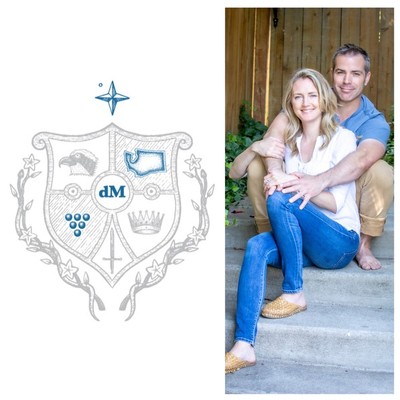
From scrubbing tanks to dusting bottles, if it’s a job in the wine industry, Peter and Kelsey Devison have probably done it. After years of making and selling wine for other folks, they recently decided to launch a label of their own, Devison Vintners. The 2018 Boushey Vineyard Rosé was one of our favorite rosés of last year, a serious rosé made by a serious winemaker that also managed to be fun and delicious. Peter assures us that the 2019 is even better!
Peter Devison studied Enology in New Zealand before running the wine programs for EFESTE and Cadaretta, two very well-known Washington wineries. This experience allowed him to established relationships with some of the best vineyards in the state, including the aforementioned Boushey Vineyard in Yakima, as well as Stoney Vine and Southwind Vineyards, located here in Walla Walla. Peter’s winemaking has a light touch. He utilizes native yeast fermentation for all of his wines, and his reds are typically neither fined nor filtered. This hands-off winemaking may seem as easy as making a list of things that haven’t been done, however, to quote Aubert de Villaine, one of the greatest living winemakers, “Nothing is more difficult than simplicity.”
An interview with Peter and Kelsey Devison:
Devison is a husband and wife team. Do you have any rules about shop talk at the dinner table?
We sit down as a family every night for dinner, which means our 3 year old generally determines the topic of conversation. That being said, he always asks, how are the grapes in your glass? That is about as far as we go at dinner or we just get interrupted.
Your 2018 Boushey Vineyard Rose was very popular in the shop. How do you approach rose production? What makes Boushey vineyard a great site for rose?
We approach this wine like a white wine, looking for freshness and acidity when we pick the fruit and it goes directly to the press with minimal skin contact native fermented for texture and complexity. The ancient soils, elevation and the Boushey’s expertise make this an exceptional site.
You make two different Walla Walla Syrahs, one from Stoney Vine Vineyard in the Rocks and one from Southwind Vineyard in the hills to the west of Milton Freewater just a few miles away. Compare and contrast the vineyards and the wines. Do you vinify the two wines differently? How do the picking dates compare?
The big differences between the two vineyards are the soil type and elevation (and thus pick dates). Stoney Vine Vineyard, in The Rocks, is at much lower elevation and planted in newer soils that consist of large river stones (like something you would see in Southern Rhone), whereas Southwind is planted almost 600 feet higher and with a steep southern exposure on much older soils consisting of fractured basalt. This imparts drastic differences stylistically, as the wine from The Rocks is extremely supple and funky with a fuller, albeit more delicate, mouthfeel contrasted with the wine from Southwind which displays more purple fruit, flowers and minerality. Stoney Vine has a lighter color as well, more in the red spectrum. Southwind is deeper, more purple/primary inn color.
The pick dates vary drastically, with Southwind coming in 3-4 weeks after Stoney Vine.
The Southwind spends less time on skin (18-21 days) and with less whole cluster inclusion (33%) compared to Stoney Vine which has 50% whole cluster and 42 days on skins.
Many winemakers who work with fruit from the Rocks have commented that the wines have a higher than average ph. Have you found this to be the case? If so, does this change your approach in the cellar?
Yes that has been the case, it doesn’t change much in my approach other than minimizing oxygen. We don’t move the wine much.
What is your cellar protocol like? I know that you specialize in native yeast ferments. How long are your fermentations? Do you use a pied de cuve? Have you had any issues?
We are 100% native. Fermentations last anywhere from 15-21 days unless extended. We do not use pied de cuve, everything is spontaneous. There is always a risk with doing spontaneous fermentation, over the years I have learned how to eliminate the potential for issues.
What do you wish the consumer knew about native ferments? What do you wish other winemakers knew?
It is a beautiful natural process that can bring more depth, richness and complexity.
Whole cluster fermentation in red wine seems to be having a moment. Do you work with whole clusters? If so, how does this affect the fermentations and the finished wines? If not, why not?
With our Rhone’s we do practice whole cluster inclusion at various rates. We like the structure it brings to the finished wine in addition to the aromatic complexity.
What’s a variety that you haven’t worked with yet that you would like to?
Gamay, of course!
What is your desert island wine?
We’d have to fight for this one if we were both on the island.
Kelsey – Nicolas Joly Coulée de Serrant
Peter – Any Barolo from Brunate Vineyard in a good vintage
How has your business been affected by the virus?
We were scheduled to officially launch in March with Taste WA and various wine dinners. We were also actively searching for a tasting room, which is on hold. We were able to shift and launch virtually, but much smaller than planned.
Are you offering delivery? Pickup? Have you changed your shipping policies?
Absolutely! We can deliver locally in Walla Walla and surrounding areas. We are also offering free shipping on orders of 6 bottles or more.
No one really seems sure how long the pandemic will last, with estimates ranging from weeks to months. How long can your business survive the current climate?
The honest answer is we just don’t know. Our strategy was to build DTC while selling directly through many of our channels in the Seattle market. It will take some time to know what that will end up looking like.

